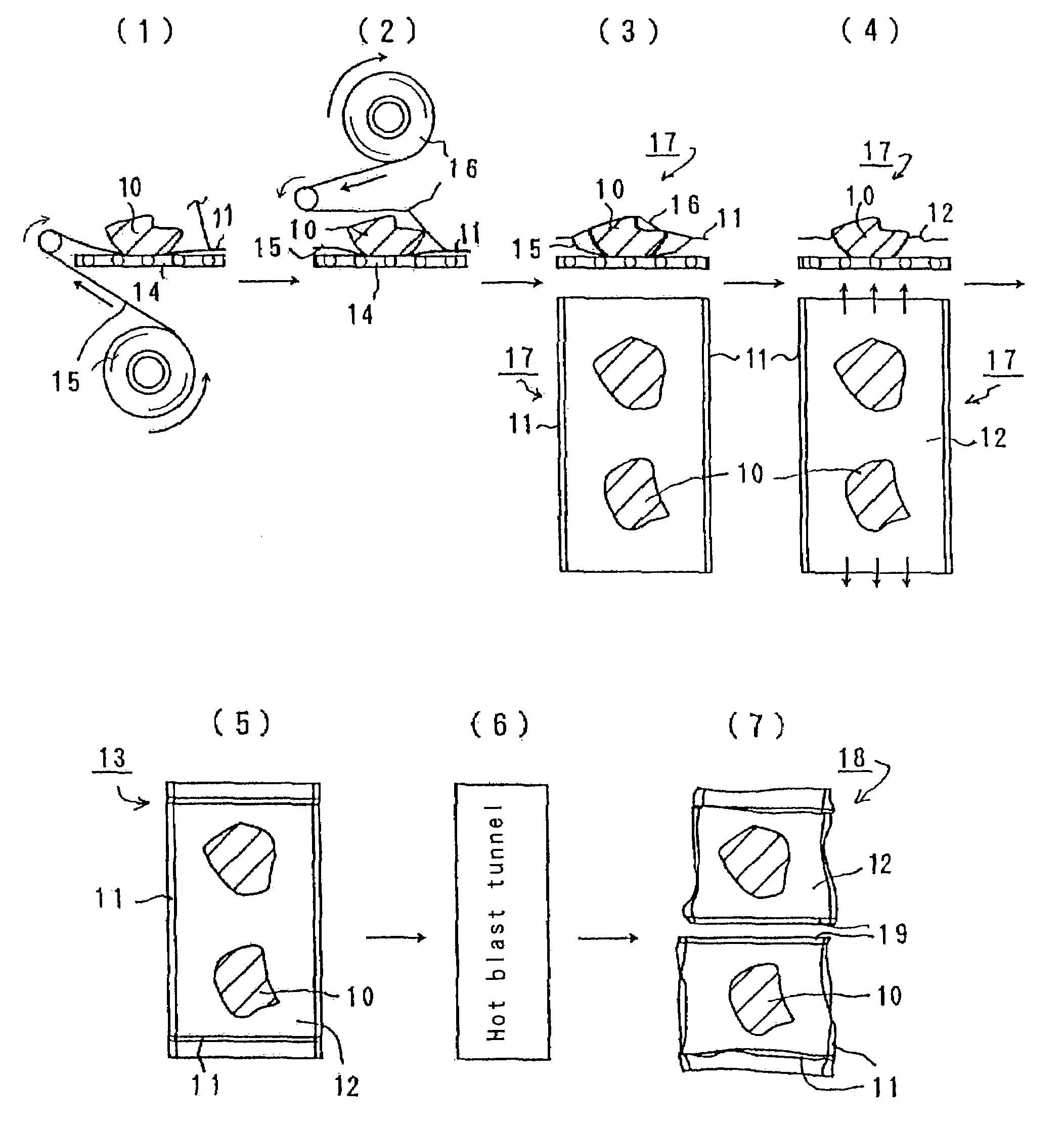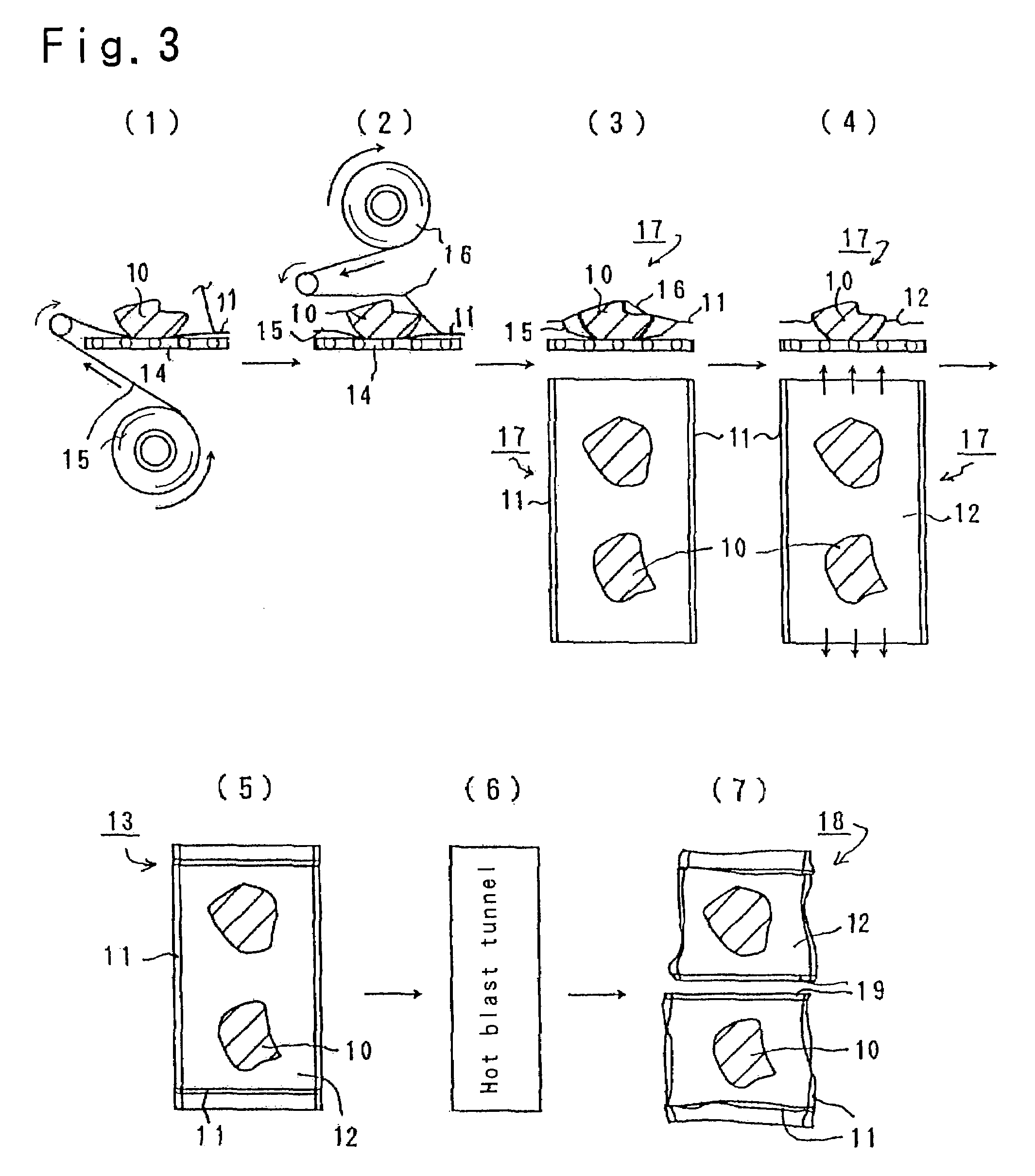Method for high-speed vacuum unitary packaging of portion-cut meats
a technology of unitary packaging and meat, which is applied in the direction of packaging foodstuffs, packaging goods, transportation and packaging, etc., can solve the problems of reducing the time required for a step for dividing with an impulse sealer, and it is difficult to uniformly heat seal a vacuum sealed packaged object, so as to achieve remarkable reduction of proportion-cut meats
- Summary
- Abstract
- Description
- Claims
- Application Information
AI Technical Summary
Benefits of technology
Problems solved by technology
Method used
Image
Examples
example 1
[0046]Portion-cut meats obtained by dividing one head of pig into thirty portions were packaged with upper and lower films having a width of 850 mm and gas-barrier properties. The films were approximately 25 μm thick, being produced by laminating a biaxially stretched polyamide layer having a thickness of 9 μm, an EVAL layer having a thickness of 4 μm, and a linear low density polyethylene layer having a thickness of 12 μm in this order. A heat shrinkage percentage of the films at 85 deg C. was approximately 5%. A melting peak temperature of the linear low density polyethylene layer, which is a thermal fusion bonding layer, was 78 deg C. as measured using a differential scanning calorimeter in compliance with JIS K 7121. Packaging was performed by performing following steps, as illustrated in FIG. 3.
[0047](1) On lower film 15 which had been unrolled to a portion-cut meat loading area on rotor conveyor 14, with the thermal fusion bonding layer being faced upward, and whose front end ...
example 2
[0060]Vacuum unitary packaged objects were obtained in the same manner as in EXAMPLE 1, except that films having a heat shrinkage percentage of 40% at 85 deg C. were used, and a method as illustrated in FIG. 5 was employed.
[0061]Step (1) was performed in the same manner as in EXAMPLE 1, except that a total of three portion-cut meats, one relatively large portion-cut meat and two relatively small portion-cut meats, were loaded as shown in FIG. 5, being separated from one another, on lower film 15. Steps (2), (3), (4) and (5) were performed in the same manner as in EXAMPLE 1.
[0062]Virtual lines in the drawing for step (5) in FIG. 5 indicate locations where films are to be fusion bonded and secondary-cut by the impulse sealer of the present invention.
[0063]At step (6), the films were fusion bonded and secondary-cut at a location of a transverse virtual line in the drawing for step (5), using the impulse sealer of the present invention, to obtain one vacuum unitary packaged object 18. T...
PUM
| Property | Measurement | Unit |
|---|---|---|
| melting peak temperature | aaaaa | aaaaa |
| width | aaaaa | aaaaa |
| melting peak temperature | aaaaa | aaaaa |
Abstract
Description
Claims
Application Information
 Login to View More
Login to View More - R&D
- Intellectual Property
- Life Sciences
- Materials
- Tech Scout
- Unparalleled Data Quality
- Higher Quality Content
- 60% Fewer Hallucinations
Browse by: Latest US Patents, China's latest patents, Technical Efficacy Thesaurus, Application Domain, Technology Topic, Popular Technical Reports.
© 2025 PatSnap. All rights reserved.Legal|Privacy policy|Modern Slavery Act Transparency Statement|Sitemap|About US| Contact US: help@patsnap.com



